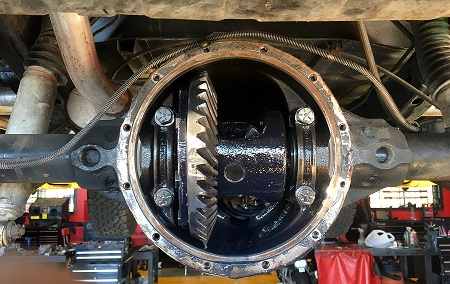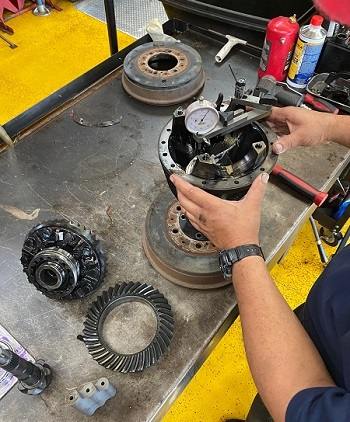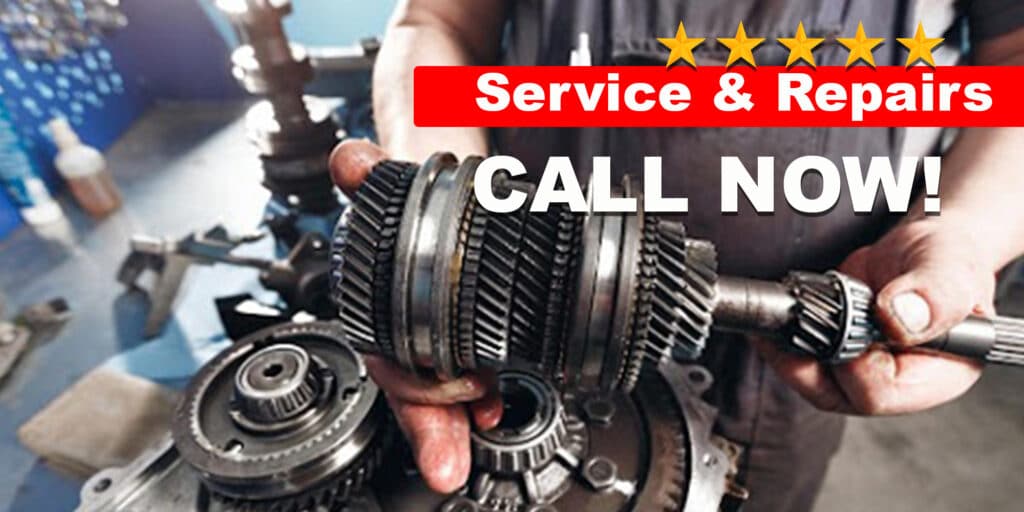
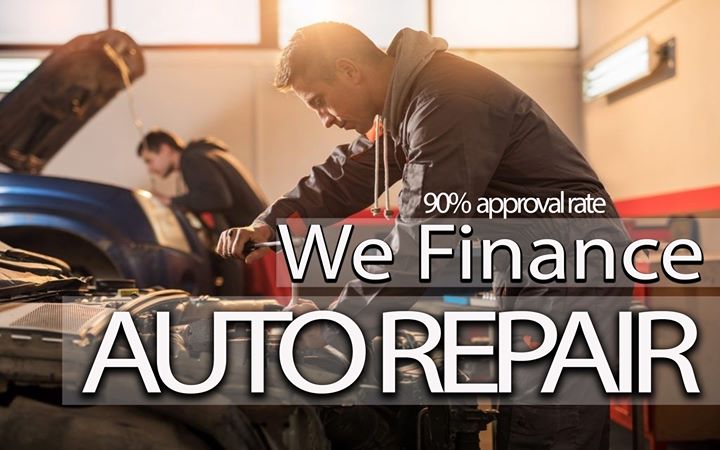
Rear and Front Differential Repair San Marcos CA
To repair a differential the right way, you need to have special equipment and professional training. At CENTRIC AUTO REPAIR, we have both, which is one of the reasons we are the best place to come to for front and rear differential repair in the North County. Our mechanics carefully go through all the necessary steps to fix your differential as well as any other issues with your transmission
The first part of the differential repair process involves draining all the oil from the differential. We then disconnect the drive shaft completely. Next, we remove the axles, differential cover, and carrier caps. Once this is completed, we perform a detailed inspection of the bearings, seals, and gears. If we notice any chipped or worn parts, we immediately replace then.
Differential Service
Differentials are built to last and are designed to handle a heavy workload. Regular service helps ensure you get the most life and best performance possible out of your gearbox. Differential fluid (or gear oil) cools and lubricates the gears and other moving components. It provides important protection against excess friction and wear. Lubricating fluid in the differential eventually breaks down due to extreme heat exposure. Over time it becomes gum-like in texture. Bits of gears can also break off, contaminating the fluid and causing it to become abrasive. Old, contaminated, or low fluid does not provide adequate lubrication for the gears. This causes unnecessary wear on the gears and can lead to more major repairs if not regularly serviced by an experienced auto mechanic. Differential Service at Auto Service Experts includes draining your car’s used differential fluid and refilling it with the manufacturer-recommended lubricating fluid to prolong the life of your differential.
Rear Differential Repair at Auto Service Experts, the Most Trusted Shop in San Marcos
It is important to have any leaks inspected as soon as possible, and follow the manufacturer’s recommended schedule for differential fluid changes. The service intervals vary quite a bit depending on the particular make and model. Front-wheel drive differentials are part of the transaxle, so no separate service is necessary. FWD differential maintenance is included in transmission service. Keep in mind that, like transmission service, differential service is necessary more often under strenuous driving conditions such as towing, off-roading, severe weather, etc. Proper maintenance is the best way to avoid having to have your differential repaired or replaced. If you are unsure about the service schedule for your particular vehicle, call and speak with one of our friendly and knowledgeable mechanics. We are always happy to answer any questions you may have.
Free Differential Diagnostic With Repairs!
The first step in proper differential repair is an accurate diagnosis. One of our ASE Master Technicians will perform computer diagnostics, inspect all components, check the fluid, and test drive the vehicle. In this way, we can determine the exact cause of the problem and the correct way to fix it. Depending on the nature and severity of the problem, you may only need minor repairs of specific components or a fluid change. In cases of severe damage, differential replacements or rebuilds are excellent long-term options. CENTRIC Technicians are professionally certified in differential repair by the National Institute for Automotive Service Excellence. We have the proper training, experience, and equipment to service and repair differentials on all makes and models including FWD, RWD, 4WD, and AWD vehicles.
3 Year/36,000 Mile Warranty on Rebuilt Differentials
Centric Auto Repair technicians have been providing premium quality differential rebuilding service in San Marcos for over 20 years. If you do require a complete rebuild, we will disassemble the unit, clean & inspect all parts, and replace them if necessary. We use only top quality and OEM parts, and back our rebuilds with the best warranty in the industry.
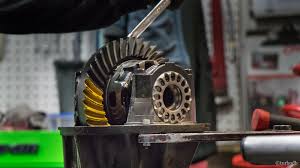
5.29 Gears on Toyota 8 Inch Locker Rear End
Drivetrain Repair
An auto drivetrain has two main purposes. The first is to evenly supply each drive wheel with power from the engine. The second is to regulate the amount of torque. A typical drivetrain contains a differential and a transmission. All-wheel and 4-wheel drive vehicle drivetrains also have a transfer case.
What is an Automotive Differential and What Does It Do?
A vehicle’s drivetrain is a system comprised of several components which work together to transfer engine power to the vehicle’s drive wheels. A differential is the part of the drivetrain which allows a vehicle to turn corners without the wheel locking up, skipping, or losing traction. When turning a vehicle, the outside wheel must travel slightly further than the inside wheel. The differential works with the transmission to enable the right and left wheels to rotate at different speeds. The difference in wheel rotation speed compensates for the slight difference in travel distance and allows for smooth turning. A differential contains many gears which help transfer power from the drivetrain to the wheels. For this reason, it is also commonly referred to as a gearbox. It is the last gear box before engine power is transferred to your vehicle’s wheels. Differentials come in different gear ratios depending on the application. Some are designed for low-end torque, some for top-end speed. On most modern vehicles, manufacturers find a happy medium between horsepower and fuel efficiency.
Pinion Depth Measurement for Gear Swap on 8 Inch Toyota Differential
On front-wheel drive cars, the differential is located inside the transaxle. On rear-wheel drive cars, the differential is located in the rear of the vehicle. On 4-wheel and all-wheel drive vehicles, there is a front end and rear end differential which have the same gear ratio. In order to change the gear ratio on an all-wheel or 4-wheel drive vehicle, you will need to replace the ring and pinion on both the front and the rear differentials. On high performance and work trucks, most

are equipped with either a limited slip differential or positrack differential which allows even amounts of torque to both rear tires at the same time.
Differential Rebuild on 1984 Jeep
Signs of Differential Problems
If you hear whining noises while turning, decelerating, or driving faster than 20mph, it may be a symptom of a failing or bad differential. Other problem signs include oil leaking from the differential seal or vibrations while driving. These symptoms indicate a lack of lubrication and should be checked out right away to avoid serious damage.
What is a Transfer Case?
In 4-wheel and all-wheel drive vehicles, the transfer case is a gear box responsible for supplying the front and rear axles with power from the engine. It also divides that power and transfers it back and forth between axles as required by traction conditions. Even if you do not use 4X4 or all-wheel drive, the transfer case still needs to be serviced because the output shaft of the transmission runs through the transfer case that supplies power to your rear differential. Even though you are not in 4-wheel or all-wheel drive you still have moving parts in the transfer case at all times when the vehicle is moving.
* Note on Towing – 4×4 and all-wheel drive vehicles need to be towed on a dolly or flatbed truck, or have both drive shafts removed before being towed. Incorrect towing will cause major damage to the transfer case and transmission and will result in costly repairs.
Transfer Case Service
The transfer case relies on fluid lubricant which prevents its gears from overheating and keeps them running smoothly. Having this lubricant replaced regularly will help keep your car’s drivetrain operating at its peak performance, and avoid more costly or premature repairs down the road.
